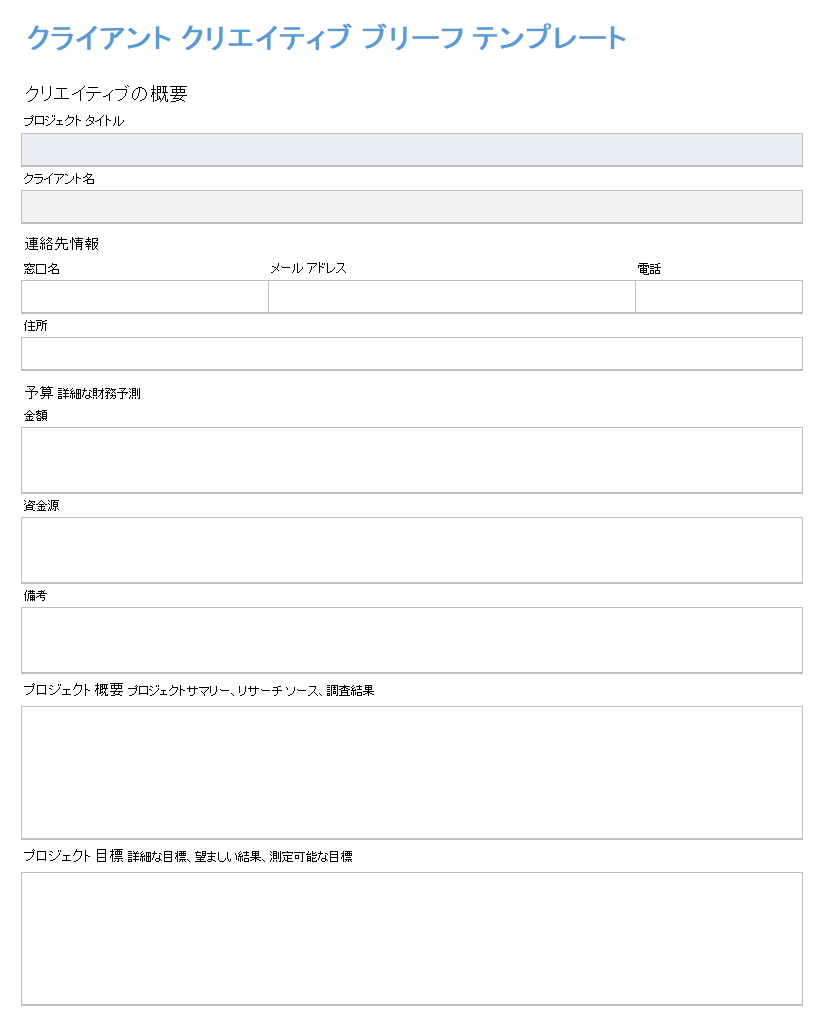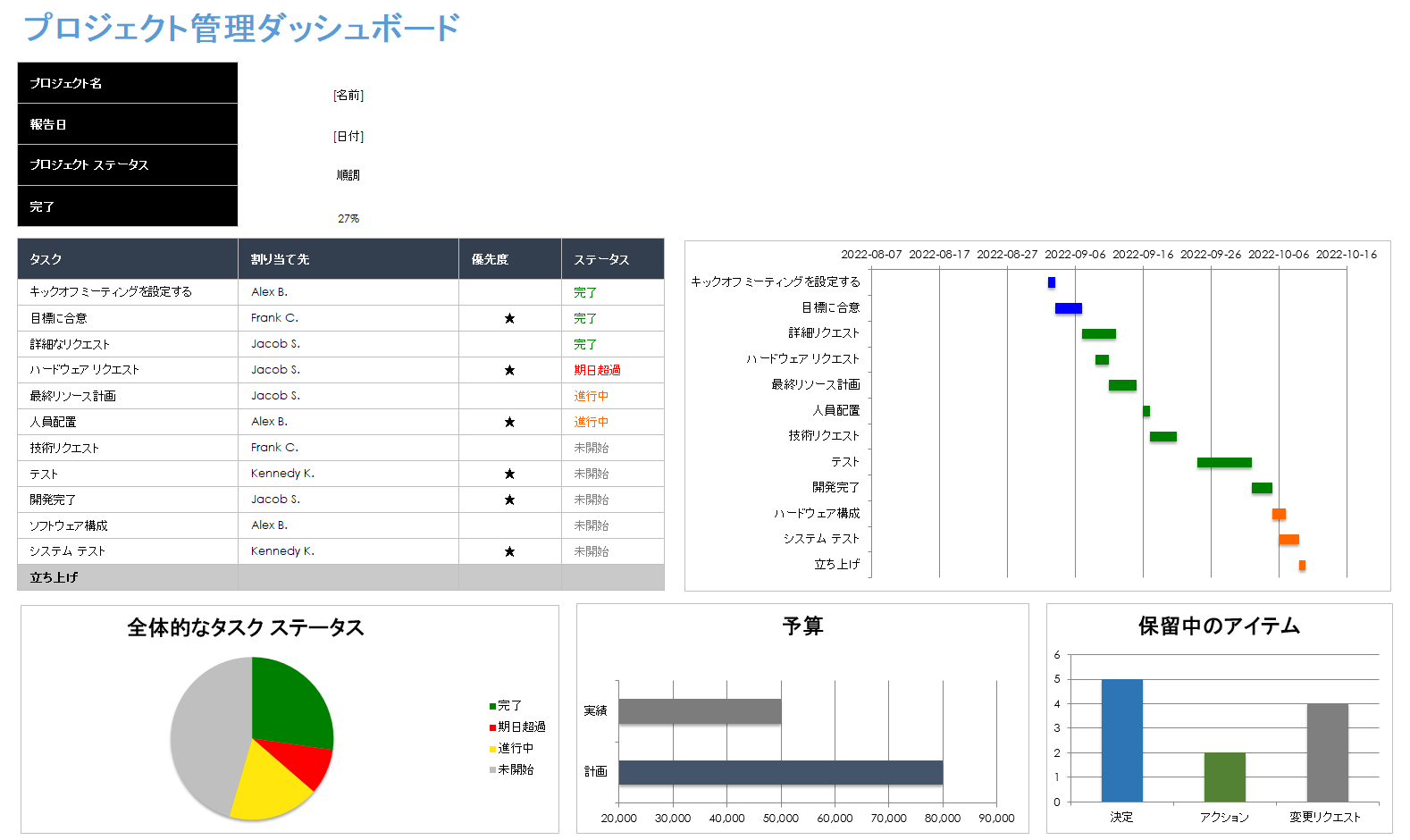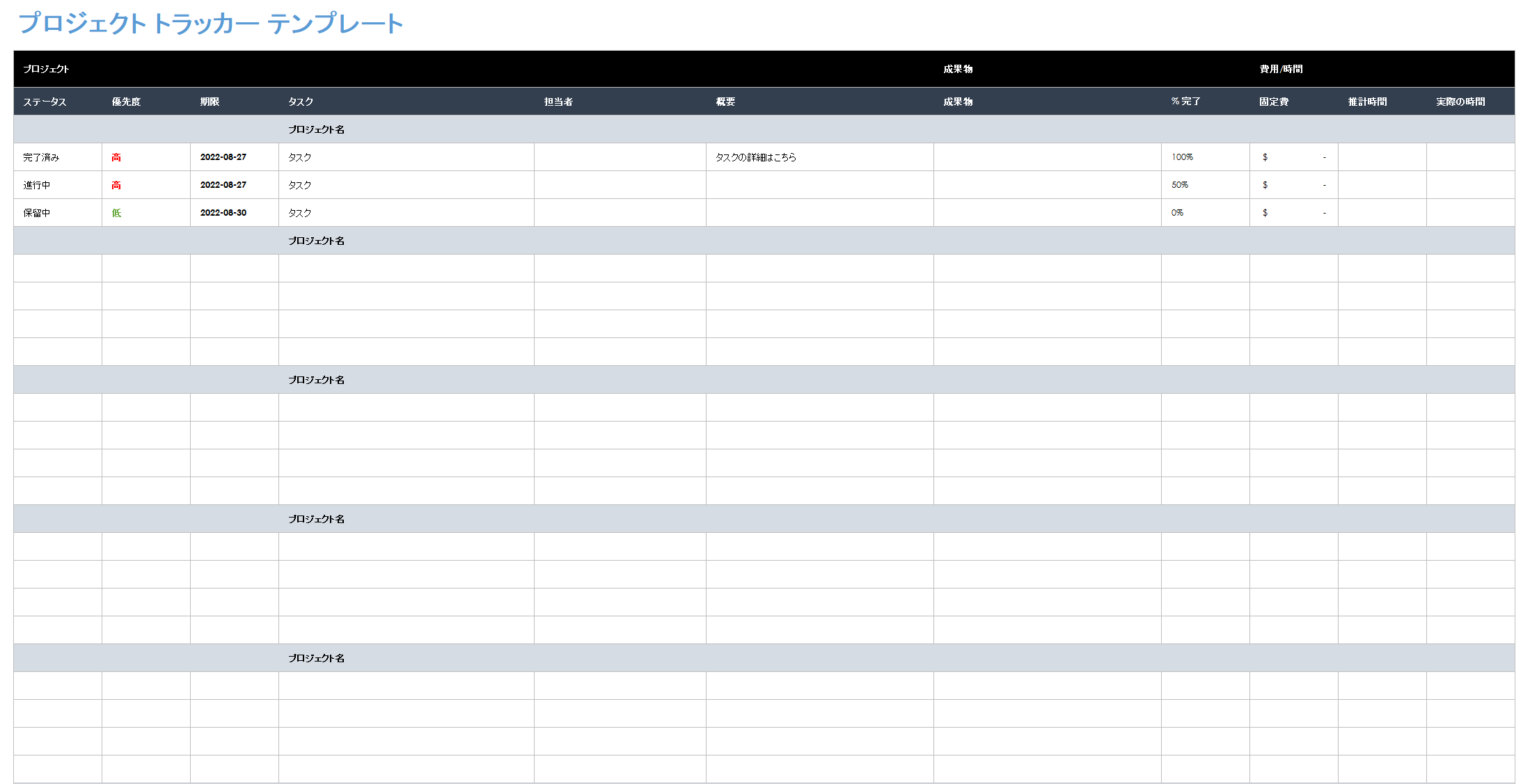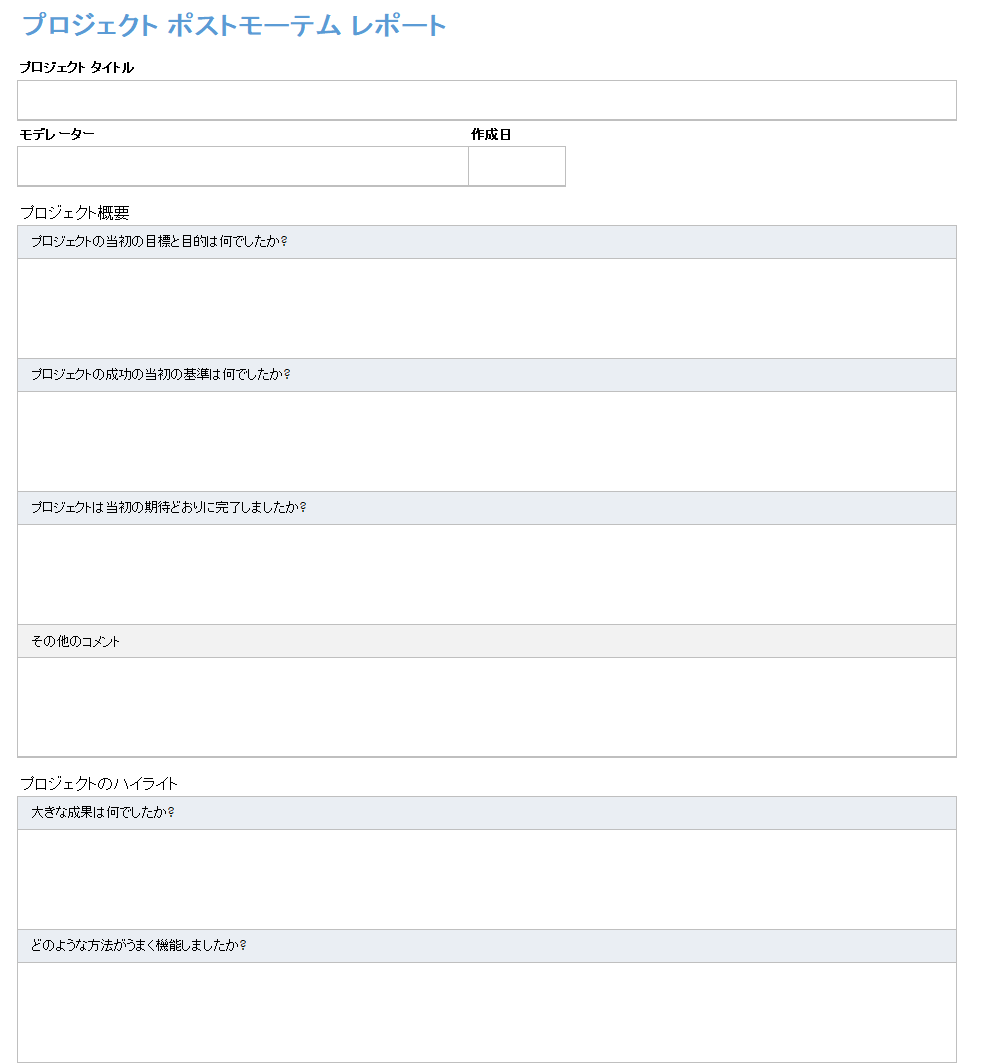What Is Creative Project Management?
Creative project management (CPM) is the process of guiding a team's effort to complete a project while fostering an environment that encourages creative ideas to flourish. This process involves balancing structured planning with the flexibility needed to embrace creative development.
The Difference Between Creative Project Management and General Project Management
Creative project management focuses on leading teams in environments such as marketing or advertising, where nurturing creativity is crucial. Traditional project management typically involves a more structured process used in fields such as construction or software development.
While these two styles have a different approach, they share the same core lifecycle and can be integrated to enhance business success and project outcomes.
Traditional project management follows a clear roadmap from beginning to end, wherein a project manager identifies roles, tasks, tools, and resources. Over the years, PMs have established and created this formal end-to-end process. Creative projects, however, don’t produce bridges or buildings. Advertising agencies, creative studios, and marketing departments are filled with idea people. Because creative projects aren’t measured by technical specifications, project managers from other industries often struggle with creative projects.
Jillian Knoepfel, Content Operations Manager at Smartsheet, explains the difference from the project manager perspective: “A creative project manager should carry out the same foundational duties that are expected from a general project manager. They should ensure that the project is on track and on budget; they should be certain that stakeholders and teams have the right information at the right time. With a holistic view of all the project components, they should be making sure that all the moving parts and people involved are connecting at the right touchpoints and advancing toward the same goal. In addition, the creative project manager should take the general project management role one step further by leveraging their knowledge of creative processes and their empathy for creative teams to deliver a project successfully.”
Like traditional projects, creative projects are time bound — they have start and end dates. So, in addition to meeting time constraints, PMs also have to manage costs and work within those boundaries. Moreover, creative project managers have to face a further challenge because creative projects are often interrelated, with tasks and activities that depend on one another.
Here are the major characteristics of creative projects:
- Creative Work Is Subjective: Creative work is hard to quantify. There are few metrics or key performance indicators (KPIs) for a good design. While nothing supersedes high-quality work, “quality” is hard to define. Establish criteria with objective language, but leave room for the creative process to evolve during a project.
- Creative Projects Are Unique: They may be similar to other projects, but they are never identical. One advertising campaign can build on elements of another, but each project is unique and you must approach each accordingly.
- Creative Projects Require Special Communication Skills: You have to translate what your clients need into specific tasks that the team can accomplish. When you manage a project, you need shared vocabulary, so you can explain what works and what doesn’t.
- A Creative Project’s Objectives Are Often Undefined: The objectives of your project are driven by the goals of the project. They need to be specific and measurable. One way to arrive at these objectives is to follow the SMART process: specific, measurable, achievable or attainable, realistic, and time bound. Learn more about writing SMART objectives and use this SMART goals template to help you.
- Creative Projects Rely on Collaboration: Unlike technical projects, which typically follow a straightforward process, creative projects are highly collaborative, unleashing creativity. In successful projects, everyone works together because collaboration is baked into every facet of the team. Involve team members when setting targets and evaluating and assigning roles. Nurture the less engaged and introverted members of the team. Encourage senior members of your team to mentor the less experienced staff. From the kickoff meeting (when you align your departments with the project goals) to the final presentation, you can monitor collaboration with regular team meetings and smaller group check-ins.
- Creative Projects Change Frequently: Clients may change their minds about what they want. Team members may have a better idea about the direction of a project. The vision of your stakeholders might not line up with your team’s creativity. While change is inevitable in any project, strong client onboarding can help you avoid surprises later. At the same time, leave enough wiggle room for creative flexibility within the project. Don’t commit to so many specifics that your team won’t be able to put its best work forward.
“If it’s true that project management is like herding cats, creative project management is like herding toddlers that are determined to draw on your walls in crayon,” says Nuala Turner, editor at The Digital Project Manager. “You still need to get everyone working to achieve the project goal on time, but you also need to leave space for creativity, which isn’t always a predictable or linear process.”
Check out this creative operations management guide for additional information on how to streamline your internal creative operations and reap the benefits of creative operations management.
Creative Project Management Process
Creative project management adapts the traditional project management cycle to meet the unique demands of creative projects. While it follows the familiar steps of initiation, planning, execution, monitoring, and closure, creative project management incorporates specific nuances at each stage.
These adjustments ensure that the creative process remains flexible and open to innovation, while still providing the structure needed to meet project goals and deadlines effectively.
Oscar Ramirez, Design Director at Smartsheet, explains where the differences in the project management cycle are most notable: “The foundational stages of project management, including scoping, conceptualization, and development, remain consistent. However, the process of gathering requirements differs significantly, especially for external agencies. These agencies must conduct more extensive requirement gathering to address all the technical aspects they neither control nor manage directly. This process requires engaging with a variety of stakeholders and adjusting the scope and details of deliveries based on client payments. Because of the number of deliveries, the types of files you deliver, and the level of detail required in each phase, the delivery stage in a CPM cycle is also different than that in a traditional PM cycle. In fact, you must manage all stages quite carefully in order to meet these expanded requirements.”
“For creative projects, the initiation and planning phases often take up a significant amount of time, leaving little room for execution. It's common for planning to consume 80 percent of the timeline, which can cramp the execution phase. As a project manager, you need to ensure that you’re allocating enough time for actual project execution,” explains Cinthya Ramírez, Creative Project Manager at Smartsheet. "Creative project management must be flexible because creative work, such as designing a video or a webpage, isn't just about following a strict process. It involves generating ideas and revisions based on feedback, which can sometimes significantly alter the project timeline."
Creative Project Management for Creative Teams
Project managers guide the work, but the team makes projects come to life. Therefore, your success depends on fostering an environment that nurtures creatives and encourages collaboration. Your company’s culture is critical to setting a tone of transparency and sharing.
The secret ingredients are your vision and philosophy for bringing people together and giving everyone a voice.
This approach plays out in how you establish your creative workflow. You’ll need to clarify roles and responsibilities to avoid duplication or conflict, while also encouraging collaboration. As you map out the workflow to support a project’s scope, make room for both creativity and efficiency. And consider software tools that work best for your team’s structure and style. Learn more about creating and implementing a creative workflow for your organization below.
When comparing a creative agency with an internal creative team, there are many qualities that overlap, but also multiple differences that impact the way in which creative projects are managed. The following table highlights some of the key differences between the two, as identified by Knoepfel:
Characteristic | Internal Creative Team | Creative Agency |
|---|---|---|
| Focus and expertise | An internal team typically has a deeper understanding of the company's brand, culture, and long-term business goals. It can develop customized content more quickly, i.e., content that aligns closely with the company’s strategic objectives. | An agency often brings a broader range of experiences and industry best practices due to working with a diverse set of clients. It can provide fresh perspectives and ideas that an internal team might overlook. |
| Scalability and flexibility | An internal team may have limitations in scaling up quickly due to hiring constraints and budget limitations. However, it offers more stability and continuous availability. | An agency may take more time to get up and running on projects due to onboarding. However, once fully briefed, it can scale resources up or down depending on the project needs, providing greater flexibility for short-term and large-scale projects. |
| Creativity and innovation | While highly knowledgeable about the brand, an internal team might become entrenched in company norms and less likely to challenge the status quo, potentially limiting creativity. | An agency often brings a fresh, outsider perspective that can spur innovation and creative solutions. Its exposure to different industries and trends can lead to more diverse and cutting-edge ideas. |
| Turnaround time and efficiency | An internal team’s familiarity with internal processes and direct access to other departments can lead to faster decision-making and execution for certain projects. However, it may also get bogged down by internal bureaucracy. | While, initially, an agency might need more time to understand the brand and its needs, it often has well-honed processes for delivering high-quality work efficiently. However, the need for coordination and communication with the client can sometimes slow things down. |
| Cost structure and benefits | An internal team usually consists of salaried employees, leading to predictable and often lower long-term costs. However, its initial setup and ongoing overhead (salaries, benefits, training) can be significant. | An agency tends to work on a project or retainer basis, which can be expensive but offers flexibility. Costs are more variable and can be high for specific campaigns, but there is no ongoing overhead when an agency is not in use. |
Creative Project Management for Creative Agencies
Successful creative agencies have built reliable processes, so they avoid starting from scratch with every project. But an agency’s process varies with client requirements. The most successful agencies are fanatical about their process because they’ve learned what works.
Make sure that your process reflects your core communication and collaboration values and that it includes the following:
- A meeting and feedback schedule that involves clients at every stage
- Regular status updates to both internal and external stakeholders
- A main point of contact between the client (external) and your team (internal)
- An agency project manager who contributes at each step of the process
- Research for your project that mines qualitative data from your agency’s database and analyzes data from other sources
“Projects at creative agencies often have less flexible deadlines, tighter budgets, and fewer resources at their disposal than projects undertaken by internal creative teams,” explains Turner. “There’s less time and freedom to come up with creative concepts, and you’re often beholden to client demands, which typically aren’t all that creative. This means that project managers have to keep a tighter leash on their team when it comes to concepting and ideation and have to keep a closer eye on the timeline.”
“Project management in creative agencies tends to be more dynamic and deadline-driven due to diverse clients, while internal creative teams often have the advantage of intimate brand familiarity,” says Gianluca Ferruggia, General Manager at DesignRush. “This deep understanding can allow for greater flexibility and experimentation.”
Creative Project Management Best Practices
Unlike conventional project management best practices, creative PM best practices require consideration of the following factors: Creative work is subjective; creative projects are unique; creative projects require special communication skills; a creative project’s objectives are often undefined; creative projects rely on collaboration; and creative projects change frequently.
Turner’s best practices suggestions focus on three areas:
- Resource Allocation: “You need to pay attention to creative skills when allocating resources. Just because your designer can do UX work, that doesn’t automatically mean they can also craft a print ad. Make sure to assign work according to the team member’s creative expertise. This will help you keep to your timeline and ensure the team stays engaged in its work.”
- Time Estimates: “Pad your time estimates, especially for the concept and ideation stages. It can take time for creative inspiration to strike. Give your team a bit of extra time to come up with something great, but know when to cut it off and focus on the essentials. This way, you’ll strike a balance between staying on track with your timeline and coming up with a creative idea that will wow stakeholders.”
- Feedback: “Be mindful when giving feedback on creative work. Creative team members often feel emotionally attached to their work, so make sure you are constructive and encouraging with feedback. If you aren’t, team members might feel less safe sharing off-the-wall ideas, and you don’t want to stifle creativity.”
“A CPM shares many of the same best practices as a general PM. However, the following two abilities in particular set a successful CPM apart: being able to continuously develop skills to best support a creative team; and being able to give the team the tools to manage the underlying processes of a project and deliver it successfully,” says Knoepfel. “By leveraging a project management or work collaboration system that seamlessly connects to resource management and digital asset management tools, a CPM is better positioned to establish and automate consistent workflows, manage timelines and creative reviews, store and distribute creative digital assets, and remove roadblocks, so the creative team can focus and innovate.”
“In my experience, successful creative project management practices include communicating clearly , providing adequate scaffolding, understanding team dynamics, and maintaining a balance between delivering the client's vision and preserving creative integrity,” says Ferruggia. “One key consideration when managing creative projects is accounting for iterations and creative blocks. Scheduling buffer time and fostering an open, feedback-driven environment are essential to nurturing the creativity of the team.”
Cinthya Ramirez highlights the importance of setting clear expectations early. “In creative projects, it's crucial to set the right expectations about timing and process from the outset. To do this, you must be up front about the rounds of feedback and revisions, which helps manage stakeholder expectations and prevents last-minute rushes that can compromise the quality of creative output." She adds that “creative projects require ongoing communication and checks with stakeholders in order to monitor progress and make necessary adjustments. Effective project management integrates these checks into the workflow to ensure that everyone is aligned and the project stays on track."
Communication is vital, not only with stakeholders but also within creative teams. Sharing information is paramount to a project’s success. “Creativity Management from the Ad Agency Perspective,” a study from the Lulea University of Technology, concluded that the right communication process boosts creativity. As the authors explain, “It is important to keep an open flow of communication and stress the significance of internal communication between all levels. An open flow of communication smooths the sequence of work and sustains a high level of creativity in the workplace. Our findings motivate us to believe that communication is the utmost underlying cause for encouraging creativity in the workplace.”
Creative Project Management Examples
Creative project management prioritizes flexibility and creativity. Due to the unique demands of creative projects, which require specialized approaches and adaptability, a PM must employ project management strategies that are tailored distinctively to these demands.
“Creative projects involve more collaboration than non-creative projects. Project managers can facilitate collaboration by holding weekly brainstorm meetings and building multiple rounds of feedback into the creative process. Also, as requirements for creative projects tend to be more ambiguous, project managers need to be more diligent about getting approvals and direction from clients or project sponsors and must clearly communicate that information to their team,” explains Turner. “Keeping a creative team motivated is more nuanced than doing such with a non-creative team. Inspiration can strike at any time, but so can creative blocks. Project managers can facilitate short daily team-building exercises or brain warm-ups like word association games to get the creative juices flowing.”
“At our agency, we approach CPM as a dynamic process, which means extensive collaboration and brainstorming sessions. At the same time, we allow more flexibility and iteration, which often involves a lot of adjustments during the development process,” explains Tom Molnar, Operations Manager at Fit Design. “Plus, the project manager is prepared for any unexpected changes and is open to trying new approaches on the go. This can make the timeline less predictable but ultimately leads to a more innovative final product.”
“Creative project management, unlike general project management, requires a strong understanding of the creative process and mutual respect for artistic freedom. I've found the need to drive creativity without hampering it is a distinctive trait of creative project management,” emphasizes Ferruggia. “A typical example of creative project management could be managing a website design project. While the goals and deadlines may be similar to any other project, the variables like design variations, creative freedom, and iterations are unique, adding a different layer of complexity.”
Oscar Ramírez highlights differences between agencies and internal teams when it comes to project delivery and evaluation. "When managing internal creative teams, controlling processes is easier. You can iterate deliverables more frequently and quickly relaunch if something goes wrong — that often means fixing issues within minutes. In contrast, at an agency, where you lack control over internal mechanisms such as website management or direct access to technical support, you might have to wait for the next website update cycle to make changes.
“At an agency, you need to use metrics and KPIs to assess success and justify your changes, or you risk losing a contract,” he added. “The extent of measurements, the team's structure, and the KPIs you establish are crucial. Additionally, the documentation required to manage your processes becomes more detailed the less control you have over a project. In contrast, in-house teams often need less documentation because they have greater control over internal factors than agencies do.”
In real-life creative project management, flexibility is not just beneficial, it's essential. Cinthya Ramirez notes that creative work requires a management approach that accommodates unexpected changes without compromising the project timeline. She uses flexible scheduling rather than fixed deadlines in order to create broader time frames, so she can account for the variability in creative tasks.
"As a creative project manager, I've learned the importance of setting realistic expectations,” says Cinthya Ramirez. “For instance, while we might plan to complete the initial phase in a week and then proceed to stakeholder reviews, the reality is that the feedback could lead to significant changes. It’s crucial to understand that sometimes, regardless of our initial plans, we may need to extend timelines to accommodate these changes. This flexibility allows us to manage projects more effectively, ensuring that all parties understand the fluid nature of creative work and the potential need for adjustments."
Smartsheet for Project Management によるクリエイティブ プロジェクト管理の改善
[efficient :ic_jp_marketing_upsell]
クリエイティブ プロジェクト管理とは?
クリエイティブ プロジェクト管理とは、チーム リーダーがプロジェクトの作業を整理および管理しながら、クリエイティブなアイデアを生み出す有機的な方法を育むプロセスです。
とは言え、プロジェクト管理分野のかなり新しい領域であるクリエイティブ PM では、何が機能し、何が機能しないのかについてのデータはこれまでほとんど生成されませんでした。しかしベスト プラクティスが進化するにつれ、確実に言えることが 1 つあります。自分のチームに合ったアプローチが必要である、ということです。インスピレーションを示してチームのモチベーションを高めること、およびチームやクライアントとのコミュニケーションに優れていることが、成功に至る 2 つの秘訣です。
クリエイティブ プロジェクト管理とは対照的に、従来型のプロジェクト管理は、建設プロジェクトやソフトウェア開発で作業を開始、計画、実行、制御、終了するプロセスです。しかし、マーケティングや広告プロジェクトをデザインするクリエイティブな人の役には立ちません。それでも、これら 2 つのスタイルは必ずしも競合しておらず、両者を活用することでビジネスに力を与え、成功に導くことができます。
従来型のプロジェクト管理では、役割、タスク、ツール、リソースを特定しつつ、最初から最後まで明確なロードマップに従います。プロジェクト マネージャーは長年にわたり、米国海軍のポラリス ミサイル潜水艦計画など、製造や防衛で使用できる正式なエンドツーエンドのプロセスを確立し、生み出してきました。
しかし、クリエイティブ プロジェクトでは、橋や建物を生み出すことはありません。広告代理店、クリエイティブ スタジオ、マーケティング部門は、発想力豊かな人で溢れています。クリエイティブ プロジェクトは技術的な仕様で測定されないので、他業界のプロジェクト マネージャーがクリエイティブ プロジェクトで苦労することがよくあります。
強力なクリエイティブ プロジェクト管理のメリット
クリエイティブ プロジェクトを強力に管理することで、会社とチームは成長できます。プロセスがなければ、創造性を適切に発揮させることができません。顧客のニーズを満たさなったり、作業を終えられなかったりするアイデアをチームが追いかけ、行き詰まるかもしれません。
クリエイティブ プロジェクト管理で、成功率は変わります。信頼性の高いプロセスを整えておけば、次のことに役立ちます。
- プロジェクトを導く。
- 健全なビジネス分析を使用する。
- リスクを最小限に抑える。
- リソースを賢く管理する。
- 提供物の品質をコントロールする。
またクリエイティブ PM を用いると、チーム メンバーが次の事態を避けられるので、チームは時間をよりコントロールできるようになります。
- 仕事のスコープ外のアイデアを追いかける
- プロジェクト管理の詳細に気を取られる
- 会議に参加し過ぎる
- 自分の役割から外れる
- チーム内の他の人の作業をする
クリエイティブ プロジェクト管理の課題は?
クリエイティブ プロジェクト管理では、独自の課題に直面します。ここで、あなたが直面する障害とその管理方法について説明します。
クライアントは非現実的な期待を抱いている
クリエイティブ プロジェクトは、レンガ製品やデジタル製品とは異なります。クリエイティブ プロジェクトではクライアントも異なります。新しい駐車場を必要とする企業が取引相手ではありません。クライアントは、自分たちが何を求め、何を必要としているのかを知らないかもしれませんし、何が欲しいのかを説明すらできないかもしれません。結果を生み出す何かを求めているだけです。そうしたクライアントと連携する方法は次のとおりです。
- 耳を傾ける: クライアントの問題点、懸念、課題を明確に理解しましょう。彼らの問題に共感すれば、協力してより明確で現実的な目標を設定できます。そうすることで、最終的には自分たちが販売できる何かだけでなく、クライアントが必要とするものを生み出す一助になります。
- 教える: あなたが行う最も重要なことの 1 つに、クライアントのオンボーディングがあります。このプロセスで、関係性の基調が決まります。この間、クリエイティブなプロセスを説明し、クライアントが望む成果物の制作にかかる時間を理解してもらい、パートナーシップ中に明確なフィードバックを提供する方法についての期待事項を設定します。
- 話す: ミーティングに出席してみると、最終製品に関する全員のビジョンが異なっていた、ということはあるでしょうか?早期に、かつ頻繁に意見を得ることで、プロジェクトを順調に進めましょう。定期的なステータス ミーティングを実施し、変更やタイムテーブルに関する期待事項を管理します。
リソースは交換可能でもスケーラブルでもない
あたかも電球を交換するかのように、クリエイティブ ディレクターを別の人物に替えてはいけません。クリエイティブな人はそれぞれ異なり、アプローチ、考え方、あるいは他者と協力するスキルはまちまちです。
同様に、プロジェクトに 5 倍の人数を加えたからといって、広告キャンペーンを 5 倍早く生み出すことはできません。また、スタッフ アワーを投入するだけでは、デザインの問題を解決することはできません。人が増えると創造性も向上するかもしれませんが、チーム メンバーを追加すると、ブレインストーミング、アイデアの検討、チームの力学の管理に費やす時間も増えます。
同様に、クリエイティブ プロジェクトの成果物は、チーム メンバーを入れ替えたり、その問題により多くの人を投入したりすることで、すぐに大量生産できるウィジェットではありません。プロジェクトを開始する際には、チームの結束力を適切に保ち、適切な人材が正しい役割を果たすようにしてください。感情的知性を使って、適切なミックスをまとめましょう。
新しいテクノロジーが従来のワークフローを妨害する
テクノロジーはスピードと柔軟性を提供します。それにより、クリエイティブ プロジェクトでの共同作業、レビュー、改善の方法が変わります。クラウドベースのテクノロジーは、次の利点をもたらします。
- 日常的なプロジェクト管理を自動化する。
- コミュニケーションを改善する。
- ソーシャルな共同作業を促進する。
- モバイル ツールを提供して、チームがリモートで作業できるようにする。
- リアルタイムのレポートを提供する。
人工知能 (AI)、拡張現実 (AR)、仮想現実 (VR) などの新しいテクノロジーによって、クリエイティブ コンテンツの制作方法が変える可能性があります。たとえば、Google (グーグル) は Sketch-RNN と呼ばれる AI 実験を通じ、ニューラル ネットワーク モデル (データを分析することでタスクを学べる複雑な数学システム) を使って絵を描けるようにしています。拡張および仮想現実は、コンテンツ作成者向けのまったく新しいプラットフォームを提供します。ここ数年で、Lowe's (ロウズ)、Home Depot (ホーム デポ)、IKEA (イケア) はアプリを開発し、自分のオフィスや家庭で製品がどのように見えるかを確認できるようにしています。
クリエイティブ プロジェクト マネージャーは、クラウドベースのテクノロジーを使用して、自分の時間とチームを最大限に活用できます。日常的なタスクを自動化すれば、今後のコンテンツ作成に集中し、競争力を維持する時間が増えます。
クリエイティブ プロジェクト マネージャーに必要なスキルは何か?
数字や成果物を重視する左脳型のプロジェクト マネージャーは、常に新しいアイデアを生み出す右脳型の創造性豊かな人たちと衝突する可能性があります。クリエイティブ プロジェクト管理を成功させるにはどうすればよいのでしょうか?クリエイティブ プロジェクト マネージャーにとって最も重要なスキルは次のとおりです。
- 多分野にわたる: クリエイティブ プロジェクト管理では、ただ 1 つの専門分野を対象とすることはもはやありません。クリエイティブ プロジェクト マネージャーは、印刷、デジタル、インタラクティブの各プラットフォームに加え、広告、イベント、マーケティング、プロモーション、テクノロジーなどのプロジェクトを理解する必要があります。
- 全体像とすべての詳細を見る: プロジェクト全体は、その各部分の合計よりも大きくなります。プロジェクトを効果的に管理するには、縮小して目標を、拡大して詳細を確認します。
- 誠実になり、品位をもって行動する: 優れたリーダーには透明性があります。知っていることを共有し、約束を守り、物事をきちんと実行します。チームに誠実さを求めていますか?自分が一番前を歩きましょう。そうすればメンバーは従います。
- 柔軟性を持つ: 最初から最後まで同じままのクリエイティブ プロジェクトはほとんどありません。状況は変わります。柔軟な態度とプロセスがあれば、適応し、俊敏さを保つのに役立ちます。
- クリエイティブになる: 問題を解決する際は、型にはまらない考え方をしてください。外でチーム ミーティングを開きましょう。具体的な締め切りではなく、目標日を設定します。また、質の高い仕事にクリエイティブな報酬を提供しましょう。
- 自己認識し、他の人を認識する: 成功しているクリエイティブ プロジェクト マネージャーは、自分の気持ちと他者の感情を認識しています。自分の気分、反応、意思決定を認識していれば、より良い決断を下すことができます。より良いフィードバックを提供し、安定感を育て、チームが能力を最大限発揮できるようにしてください。
- クリエイティブな人たちとの過去の経験: 従来型のプロジェクト管理アプローチでは、クリエイティブな製品を作ろうとしているクリエイティブな人たちが相手だと機能しません。チームには、集中力が極めて高く詳細に目を向けるメンバーもいれば、期日やスコープを気にせず自由に行動するメンバーもいることを、クリエイティブ プロジェクト マネージャーは知っています。クリエイティブな人たちの大半にとって、仕事は自分のアイデンティティの延長であり、フィードバック、特に自分の仕事への批判に極めて敏感になりがちです。こうした性格の人にアプローチする方法を知っていれば、管理が大変だとは思わなくなります。
- 平和的かつ生産的に対立を解決する: 人々が協力しているプロジェクトでは、対立が生じる可能性があります。私たちは皆人間です。ブレインストーミングを行ってアイデアを洗練させる際、対立がクリエイティブ プロセスの一部になる場合すらあります。しかし、対立を悪化させてはいけません。プロジェクト マネージャーは、チームを導いて緊張を和らげ、必要に応じて審判役を務め、共通点を見つけ、敬意を取り戻す必要があります。チームの雰囲気が悪いと、質の高い作品を生み出せず、組織全体の文化に悪影響を及ぼします。これを軽減するには、コミュニケーションの源になる方法を学びましょう。
- 最新の業界知識を常に把握する: マーケティングや広告のトレンドを知ることで、信頼性を確立しましょう。またプロジェクトの管理、創造性の促進、プロジェクトの正確な予測に役立つ最新のテクノロジー ツールに精通してください。
- プロジェクト管理認定資格を検討する: プロフェッショナル認定を取得して、自分の技量、評判、価値を高めましょう。Project Management Institute (プロジェクト マネジメント協会: PMI) ® は、プロジェクト管理に携わるさまざまなプロフェッショナル向けのプログラムを提供しています。また Brainmeasures (ブレインメジャーズ) は、特にクリエイティブ プロジェクト マネージャー向けに設計されたプログラムを用意しています。さらに、多くの大学が忙しいプロフェッショナル向けのオンライン プログラムを提供しています。
クリエイティブ管理のベスト プラクティス
プロジェクト マネージャーはクリエイティブであると同時に、マネージャーでもある必要があります。どんなプロジェクトであっても、創造性をその中心に置きます。特に、これまで従来型のプロジェクト管理に携わり、創造性にあまり縁がないと思っている場合は、クリエイティブ思考のマスターになりましょう。ここでは、自分自身のクリエイティブ思考を育む方法をいくつかご紹介します。
- 好奇心を持つ: プロジェクトで発生した問題であれ、仕事帰りの渋滞であれ、その理由を自問してください。なぜこれが起きたのか?
- 興味を広げる: 自分の専門分野ではない本を読んだり、映画を見たりしましょう。
- 書き留める: 疑問やアイデア、あるいは自分が知った楽しい事実を、メモやファイルにまとめましょう。
- 楽しむ: 休みを取り、体と脳を自由に歩かせましょう。仕事でも遊び心を持ち、職場におもちゃをいくつか持ち込みます。
マネージャーとして、プロジェクトの中心に人を置きます。クリエイティブ管理には共感が必要です。周囲のクリエイティブな人々の視点や問題を理解する必要があります。
チームには、アート ディレクター、グラフィック アーティスト、写真家、デザイナー、コピーライターなど、様々なタイプのクリエイティブな人が揃っています。あなたの役割は、多岐にわたるクリエイティブな個性を育み、彼らの風変わりさと特徴を理解することです。クリエイティブな人たちについて知っておくべきことを以下に示します。
- 彼らはマイクロマネジメントではなく、ロードマップを求めています。どのようにしてほしいのかではなく、プロジェクトで何をしたいのかを伝えます。
- 彼らは自分たちの仕事を深く、そして個人的に気にしています。フィードバックを提供する際は、適切に賞賛しながら、思慮深い指導を行います。
- 彼らには明確なフィードバックが必要です。気に入らないことがあれば、自分がそう反応した理由を言ってください。デザインがごちゃごちゃしすぎていますか?コピーが専門用語や決まり文句でいっぱいですか?批判的な物言いではなく、客観的な言葉を使いましょう。
- インスピレーションは、オンデマンドで得られるものではありません。コンテンツ作成者に必要な時間とスペースを提供します。何もしていないように見えることもありますが、水面下では創造性を働かせています。
- このような人は、アイデアを言葉にできないビジュアル思考者です。彼らの作品がクライアントの期待に合わない場合は、あなたが支持者、翻訳者、仲介者になる必要があります。
- 彼らは頻繁に新しいアイデアを得ますし、チームの他のメンバーとアイデアのキャッチボールをする必要があります。そのアイデアでプロジェクトが改善するかどうかについて、心を開いて考えましょう。プロジェクトを変える可能性すらあります。しかし、うまく行きそうになければ、はっきりノーと言いましょう。
- 境界は創造性を高めます。作業のスコープやプロジェクトの制約事項を明確にするとともに、定義した範囲内で何ができるかを、彼らがどう探っているかを見てください。
クリエイティブ プロジェクト管理のベスト プラクティス
従来型のプロジェクト管理のベスト プラクティスとは異なり、クリエイティブ プロジェクト管理のベスト プラクティスでは、クリエイティブな作業は主観的である、クリエイティブ プロジェクトはユニークである、クリエイティブ プロジェクトでは特別なコミュニケーション スキルが必要である、クリエイティブ プロジェクトでは目標が定義されていないことがよくある、クリエイティブ プロジェクトは共同作業に依存している、クリエイティブ プロジェクトは頻繁に変化する、といった要因を考慮する必要があります。
一方、従来型のプロジェクト管理では、プロジェクトとその複雑さを定義するロードマップが提供されます。それにより、マネージャーはプロジェクトのすべての要件をまとめ、次の 5 つのフェーズを通じて進捗を監視できます。
- 開始
- プランニング
- 実行
- 監視とコントロール
- 終了
このプロセスを用いることで、プロジェクト マネージャーはタイムラインを守り、予算を監視し、スコープ クリープの問題を解決し、成功を推進できます。クリエイティブ プロジェクト管理でも作業の整理と管理を行いますが、クリエイティブなアイデアを生み出す有機的な方法を育てるという、もう 1 つの要因が加わります。
クリエイティブ プロジェクト管理は従来のアプローチとどのように異なりますか?
従来型のプロジェクトと同じく、クリエイティブ プロジェクトには期限があり、開始日と終了日があります。それら時間的制約を満たすだけでなく、その境界内でコストと作業を管理する必要があります。多くの場合、クリエイティブ プロジェクトは相互に関連しており、互いに依存するタスクやアクティビティで構成されています。
言い換えると、従来型のプロジェクト管理はクリエイティブ プロジェクトにおいて不十分な場合があるのです。
-
クリエイティブな作業は主観的である: クリエイティブな作業は数値化するのが困難です。優れたデザインについて、それを測る指標や主要業績評価指標 (KPI) はほぼ存在しません。高品質の作業に優るものはありませんが、「品質」は定義しづらいものです。客観的な言葉で基準を設定しますが、プロジェクト中にクリエイティブ プロセスが進化する余地を残しましょう。
-
クリエイティブ プロジェクトはユニークである: クリエイティブ プロジェクトその他のプロジェクトと似ているかもしれませんが、決して同じではありません。ある広告キャンペーンを、別のキャンペーンの要素を基に作成することもできますが、それぞれプロジェクトはユニークであり、それに応じて各キャンペーンに取り組む必要があります。
-
クリエイティブ プロジェクトでは特別なコミュニケーション スキルが必要である: クライアントが必要とするものを、チームが達成できる特定のタスクに変換する必要があります。プロジェクトを管理する際は、何が機能して何が機能しないかを説明するために、共通の語彙が必要です。
-
クリエイティブ プロジェクトでは目標が定義されていないことがよくある: プロジェクトで何を目指すのかによって、そのプロジェクトの目標が決まります。そうした目標は具体的かつ測定可能でなければなりません。SMART プロセス (具体的 (Specific)、測定可能 (Measurable)、達成可能 (Achievable または Attainable)、現実的 (Realistic)、期限付き (Time bound)) に沿って考えるのが、そうした目標を立案する方法の 1 つです。SMART 目標の策定についてはこちらをご覧ください。また、策定の際はこのテンプレートが便利です。
-
クリエイティブ プロジェクトは共同作業に依存している: 単純なプロセスに従うのが一般的な技術プロジェクトとは異なり、クリエイティブ プロジェクトでは共同作業を前面に出し、中心に置くことで創造性が流れるようになります。優れた成果を上げるプロジェクトでは、共同作業がチームのあらゆる側面に組み込まれているので、全員が一緒に作業します。ターゲットを設定し、役割を評価して割り当てる際は、チーム メンバーを巻き込みましょう。また、メンバーが何かに没頭することが少なく、内向的でないチームを育ててください。さらに、経験の少ないスタッフを指導するよう、チームのベテラン メンバーに促しましょう。キックオフ ミーティング (プロジェクトの目標と部門の足並みを揃えるタイミング) から最終プレゼンテーションに至るまで、定期的なチーム ミーティングや小規模なグループ チェックインを行うことで共同作業を監視できます。
-
クリエイティブ プロジェクトは頻繁に変化する: クライアントは、自分が何を望んでいるかについて心変わりするかもしれません。チーム メンバーは、プロジェクトの方向性についてより良いアイデアを持っているかもしれません。関係者のビジョンは、チームの創造性と一致しないかもしれません。どんなプロジェクトでも変更は避けられませんが、強力なクライアント オンボーディングを行うことで、その後の予期せざる事態を避けるのに役立ちます。同時に、プロジェクトでクリエイティブな柔軟性を保つ十分な余地を残します。詳細に専念しすぎて、チームが最善を尽くせなくなる事態を避けてください。
クリエイティブ プロジェクト管理を合理化するには
プロジェクト管理では、プロジェクトを開始 (またはアイデア化)、プランニング、実行、コントロール、プロジェクト終了の 5 つのフェーズに分割します。プロジェクトはクリエイティブですが、それでもプロセスが必要です。ここでは、プロジェクトに合わせてこれらのステップを最適化する方法を紹介します。
- 開始/アイデア化: プロジェクトの基礎となるのがクリエイティブ ブリーフです。クライアントと協力して、プロジェクトのゴールと目標、全体的な予算とタイムライン、役割と責任を特定します。このクライアント クリエイティブ ブリーフ テンプレートを使用して開始しましょう。ここではクリエイティブの概要を説明するとともに、クライアントの連絡先情報を記載するスペースと、プロジェクト予算、概要、目標、マーケティング ガイドラインを説明するスペースがあります。
クライアント クリエイティブ ブリーフ テンプレートのダウンロード
- プランニング: ゴールと目標を特定したら、そこに到る方法を計画します。タスクを整理し、スケジュールを作成し、コストを見積もり、リスクを特定する必要があります。この既成のマーケティング計画テンプレートを使用して、ビジネスの目的、戦略的目標、ターゲット市場、パフォーマンス基準を概説し、しっかり練られた綿密な行動計画を立てることができます。
マーケティング計画テンプレートのダウンロード
- 実行: 計画を立てたら、次は作業に取りかかります。プロジェクト トラッカーを用いることで、スケジュールと予算を超過していないかや、ボトルネックやリスクがある場所を特定できます。このプロジェクト管理ダッシュボードによって、プロジェクト マネージャーは特定のプロジェクトに関するさまざまな側面を把握し、それを単一のスナップショットで表示できます。このダッシュボードには、プロジェクトの全体的なタスク ステータス、予算、保留中のアイテムを表すチャートや、タスクを割り当てるスペースなどがあり、最新のプロジェクト ステータス レポートを提供したり、チーム メンバーと情報を共有したりできます。
プロジェクト管理ダッシュボード テンプレートのダウンロード - Excel
- 監視とコントロール: プロジェクト (特にクリエイティブ プロジェクト) は、作業を行う中で進化します。クライアントのフィードバックと承認に関する優れたツールを用いると、全員が同じ情報にアクセスでき、プロジェクトのスコープ内に留まっていることを確認できます。このプロジェクト追跡管理テンプレートを使用して、プロジェクト全体のタスク、ステータス、優先度、成果物、期限、コスト、時間などを入力してください。特に大規模なプロジェクトを管理している場合には、このテンプレートを使用してすべてを整理することをお勧めします。
プロジェクト追跡管理テンプレートのダウンロード
- 終了: プロジェクトが完了したら、何が機能したか、何が機能しなかったか、次のプロジェクトに向けて何を改善できるかを評価します。チーム (または少なくとも主要メンバー) を集めて成功を祝い、教訓を確認し、プロジェクトのすべての段階のパフォーマンスを分析します。このポストモーテム テンプレートを使用することで、問うべき質問を確認できます。成果、問題領域、教訓など、プロジェクトの詳細がハイライト表示されていて、プロジェクトのすべての要素のパフォーマンスを分析するプロセスが容易になります。
プロジェクト ポストモーテム テンプレートのダウンロード
オンラインのクリエイティブ プロジェクト管理では、プロセスを確実に実行しつつ、プロジェクトをよりスムーズに進め、効率を改善し、共同作業を促進して、創造性を最大限に引き出すことができます。プロジェクト管理ソフトウェアのメリットと、自分のニーズや組織に最適にフィットさせる方法をご覧ください。
クリエイティブ チーム向けのプロジェクト管理
プロジェクト マネージャーは作業を導きますが、プロジェクトに生命を吹き込むのはチームです。したがって、成功するかどうかは、クリエイティブな人材を育て、共同作業を促す環境を育むことにかかっています。透明性と分かち合いの基調を決める際は、企業の文化が鍵を握ります。そこに、人々を結び付け、発言する機会を全員に与えるビジョンと哲学を加えます。
このアプローチは、クリエイティブなワークフローを確立する上で特に重要です。重複や対立を避け、共同作業を促すために、役割と責任を明確にする必要があります。ワークフローを作成してプロジェクトのスコープをサポートする際は、創造性と効率のスペースを設けましょう。また、チームの構造やスタイルに最適なソフトウェア ツールも検討してください。組織のクリエイティブ ワークフローの作成と実施については、この記事をご覧ください。
クリエイティブ エージェンシー向けのプロジェクト管理
優れた成果を上げるクリエイティブ エージェンシーは、信頼性の高いプロセスを構築しており、あらゆるプロジェクトで一から始めるのを避けています。しかし、エージェンシーのプロセスはクライアントの要件によって異なります。最も成果を上げているエージェンシーは、何が機能するのかを学習済みなので、自分たちのプロセスにこだわっています。
コミュニケーションと共同作業の中核価値がプロセスで反映されていて、次のものが含まれていることを確認してください。
- すべての段階でクライアントが参加する、ミーティングとフィードバックのスケジュール
- 社内外の関係者に対する定期的なステータス更新
- クライアント (外部) とチーム (社内) の主要連絡先
- プロセスの各ステップで貢献するエージェンシー プロジェクト マネージャー
- エージェンシーのデータベースから定性的なデータをマイニングし、他のソースからのデータを分析するプロジェクトの調査
Smartsheet でコンテンツのレビュー プロセスを加速
Smartsheet と Adobe を使用すると、コンテンツの状況が今後変化し続ける中でも、チームはプロセスを合理化し、生産を拡大させ、インパクトのあるアセットを継続的かつ期限内に提供できます。現在の作業を校正にアップロードし、組織内外の関係者にフィードバックをリクエストすることで、Smartsheet で直接レビュー プロセスを開始しましょう。作業が迅速かつ効果的になり、スケジュール通りにアセットを提供できます。










